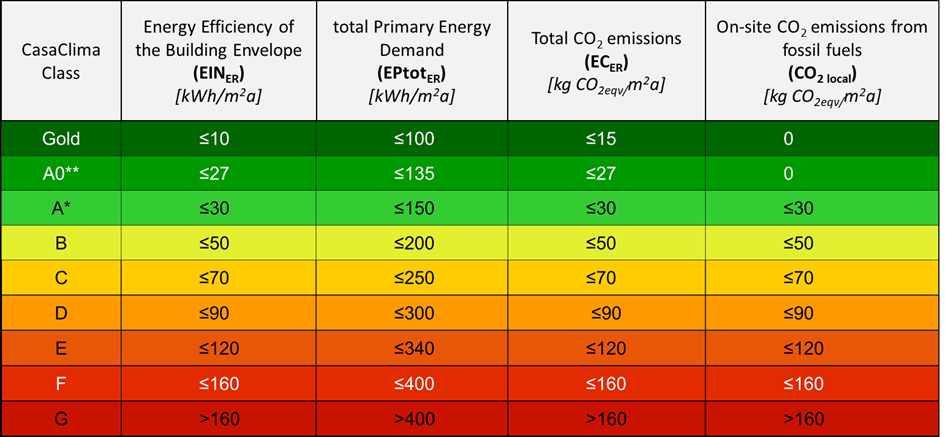Last October, the Council of the Autonomous Province of Bolzano approved the new Energy Performance of Buildings Decree implementing Directive (EU) 2024/1275 (hereinafter referred to as the Decree). In March, the procedure for notifying the Regulations to the European Commission was successfully completed and on 21 March the Regulations entered into force. As is well known, the new EPBD aims in particular to reduce the environmental impact of energy use in the buildings sector and to achieve zero emissions from buildings by 2050. To achieve this goal, different areas of intervention have been identified, ranging from the decarbonisation of the new and existing building stock to increasing the use of renewable energy sources (RES). New metrics for the CasaClima energy certificate. The CasaClima energy certificate has been modified to include two new indicators:
- the total primary energy demand (PED), which takes into account energy from both renewable and non-renewable sources, expressed in kWh/m2a;
- the on-site CO2 emissions from fossil fuels, expressed in kgCO2eqv/m2a.
A new efficiency class, A0, has been introduced for buildings that are able to reduce on-site CO2 emissions from fossil fuels to zero and are 10% more energy efficient than a Near Zero Energy Building (nZEB). From 2028, the A0 class will be mandatory for new public buildings and from 2030 for all new buildings, regardless of their use. As before, the CasaClima class of the building corresponds to the lowest efficiency class among those indicated in the energy certificate. The metrics is linked here. New buildings: what’s new For new buildings, 60% of the primary energy demand (PED) – 65% for public buildings – must be covered by renewable energy sources (RES), and PV systems must be installed to provide at least 50 W/m2 of built area. From 2028, all new buildings with a Net Heated Area (NHA) greater than 1000 m2 will be required to calculate their GWP. From 2030, the obligation will apply to all new buildings. Until a common European calculation method is defined, the GWP will be calculated according to the CasaClima sustainability protocol Nature. This means that the CO2 equivalent emissions resulting from the production of the building materials and their replacement (LCA modules A1-A2-A3) during the life cycle of the building (assumed to be 100 years) will be taken into account, considering only the components and assemblies that make up the thermal envelope of the building. Existing Buildings: what’s new Specific guidance has been provided for buildings interested in major renovations, i.e. interventions affecting more than 25% of the building surface or extensions of more than 25% of the useful area. For example, residential buildings with an NHA of more than 1000 m2 and non-residential buildings with an NHA of more than 500 m2 must meet their electricity needs with at least 25 W per m² of built area from renewable energy sources. If a system replacement is planned, the building’s PED must be met with 30% renewable energy or reduced by at least 25%. For existing non-residential buildings, a renovation plan is already defined. Based on a statistical sample of existing buildings in the province, it has been verified that the PED for HVAC and lighting is 750 kWh/m2a for 16% of them and 600 kWh/m2a for 26% of them. All non-residential buildings must demonstrate that their PED produces an Energy Certificate by 31.12.2026 and, if they do not meet the above threshold, must reduce their PED below 750 kWh/m2a by 2030 and below 600 kWh/m2a by 2033. Exceptions will be considered in the case of a negative cost-benefit analysis. Electric mobility and Building Automation Specific requirements to facilitate the diffusion of electric vehicles have been defined for both new buildings and existing buildings undergoing major renovation (minimum number of charging points, pre-wiring, etc.). For new buildings or when replacing heating/cooling generators, the installation of devices that automatically control the temperature in each room or in a specific area is required. In particular, new multi-family buildings and those undergoing major renovation from 2026 should be able to respond to external climatic conditions. Non-residential buildings will be required to install automation and control systems and automatic lighting controls. There are different deadlines depending on the total power of the installed systems. Fundings In order to facilitate the application of all these requirements in the case of existing buildings, the Autonomous Province of Bolzano (APB) has defined direct funding reserved for existing buildings belonging to private owners, non-profit organisations, companies and public administrations. They can be combined with state contributions or subsidies only in the case of public buildings. The direct subsidies can reach different values in relation to the eligible costs, depending on the energy performance achieved thanks to the renovation intervention. The APB also offers indirect financing in the form of an increase in volume, known as the energy bonus. New buildings can increase their volume by 10% if they apply the voluntary sustainability protocol CasaClima Nature. Existing buildings, on the other hand, can increase their volume by 20%, up to a maximum of 200 m3, if they reach CasaClima efficiency class B or C (depending on when the building was constructed), or CasaClima R if they are subject to specific restrictions due to higher legislation (historic buildings, etc.).
